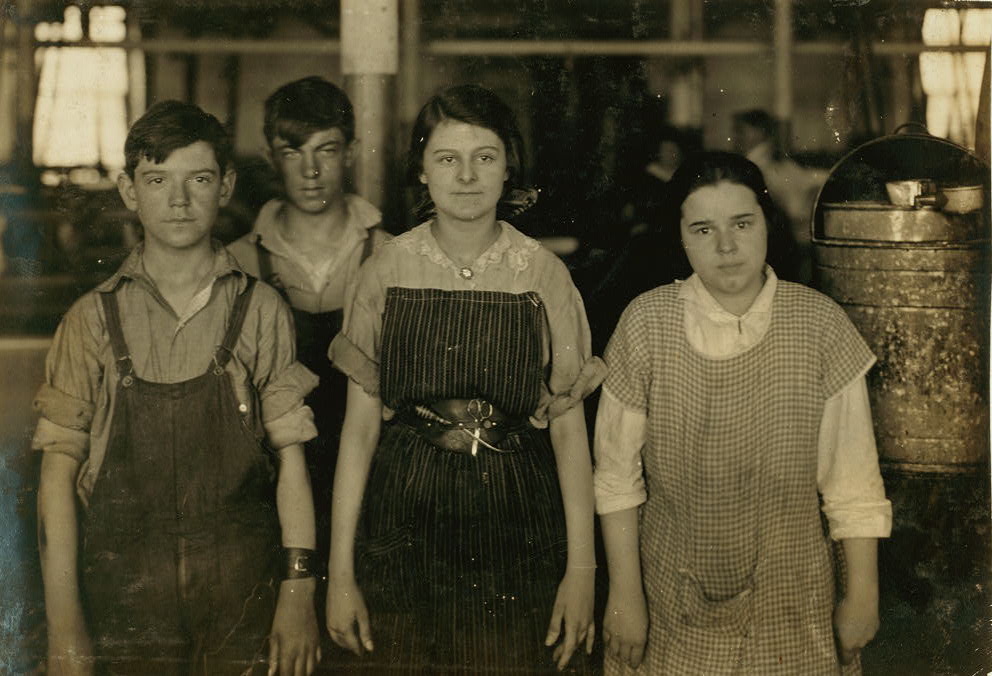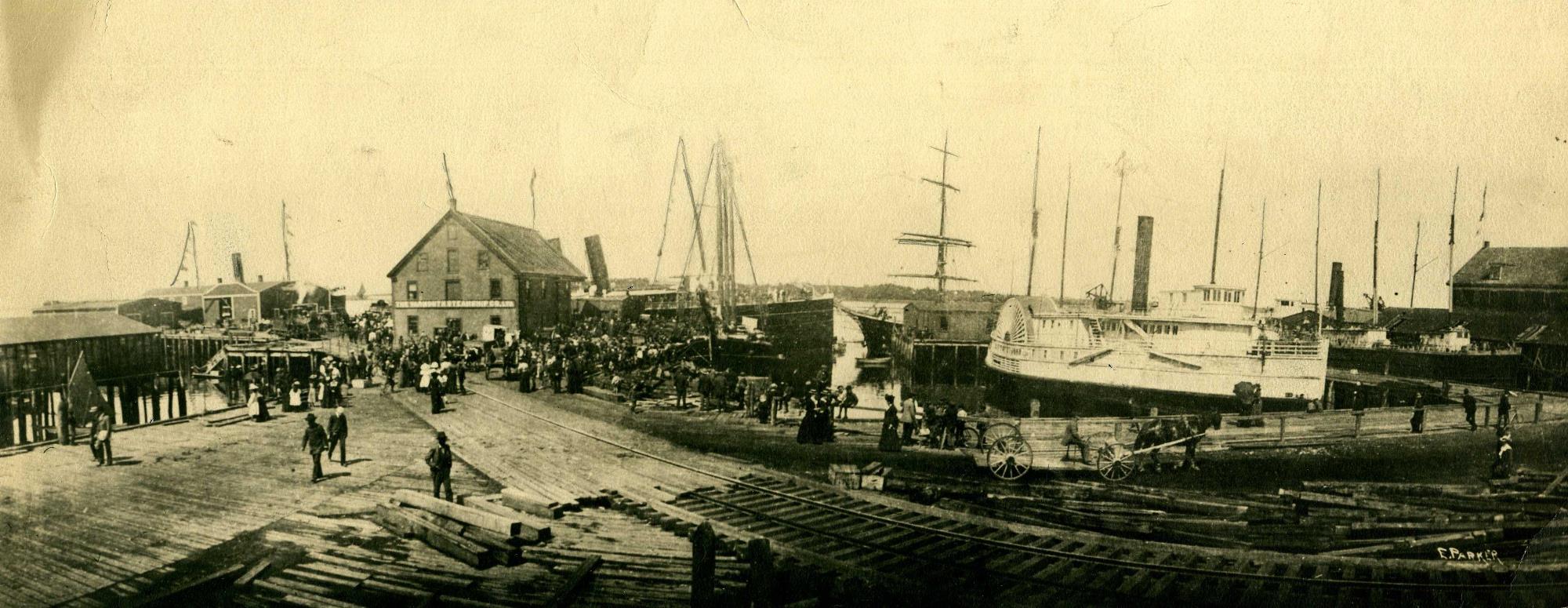French Canadian child laborers at the Kerr Thread mill in Fall River, Massachusetts, 1916. Photograph by Lewis Hine, Library of Congress.
The majority of Canadian immigrants to Boston belong to two groups: English-speakers from the Canadian Maritimes (Nova Scotia, New Brunswick, and Prince Edward Island) and French Canadians from Québec and surrounding areas of eastern Canada. As the provinces of British North America only united as a confederation in 1867, there was little sense of Canadian nationalism until a century later. Provincial, ethnic, and religious identity and loyalty were thus more central to Canadians in Boston.
The first wave of immigrants from the Maritime Provinces arrived in New England between the 1860s and 1890s. Industrialized manufacturing put many traditional craftsmen out of work, and increased mechanization of the lumber and fishing industries displaced many loggers and fishermen. Rural farmers in the Maritimes also suffered from Britain’s elimination of protective tariffs for its North American colonies. Initially, most immigrant Maritimers were young, unmarried men who intended to stay temporarily, but towards the 1890s increasing numbers of families migrated and stayed permanently. The second wave of Canadian Maritime immigration lasted from the 1920s to the early 1930s, comprised again of primarily blue-collar workers fleeing the collapse of both the rural and industrial economies of Atlantic Canada.
French Canadians who immigrated to New England came in three different waves. From the 1840s to the 1880s, economic hardship and political instability in Québec spurred the first group, who frequently returned home. The second (1880-1895) and third (1923-1929) waves were caused by similar factors as the Maritime migrations: agricultural failures, the repeal of protective tariffs, and instability in Québec’s lumber and milling industries.
Both Maritime and French Canadians frequently went back and forth to their home provinces, following the ups and downs of the Massachusetts labor market. Some also practiced seasonal migration to western Canada, where they worked the harvests in the late summer and fall. Rather than return to the Maritimes, many found their way to Boston.
During and after the Great Depression, immigration from both Québec and the Maritimes decreased, and some earlier migrants returned to Canada. Despite the imposition of quotas for Canada beginning in the 1970s, Canadian immigration to the US grew in the post-World War II era and has shifted toward white-collar technical and professional workers.
Settlement
Both Maritimers and French Canadians tended to settle in New England, due to its geographical proximity to their homelands and the economic opportunities provided by industrialized New England. According to the 1880 Census, 57 percent of all Nova Scotian immigrants in the United States lived in Massachusetts, as did 29 percent of New Brunswickers and 50 percent of Prince Edward Islanders.
About 20 percent of all Maritimers lived in Boston in 1880. In the early twentieth century, many settled in the city’s “streetcar suburbs” of Roxbury, Dorchester, East Boston, and West Roxbury. Other Maritimers made their homes in nearby Cambridge and Lynn. Unlike the more homogenous French Canadian community, Maritimers tended to live among neighbors with whom they shared ethnic or religious ties. For example, Irish Catholics from New Brunswick identified more closely with the South Boston Irish than with ethnic English or Scottish Protestants from New Brunswick, and a similar phenomenon occurred with Nova Scotian Presbyterians and immigrants from Scotland in East Boston.
Scottish Presbyterian churches, founded in the South End in the 1880s, were clustered around “Scotch Corner” (Warren Ave. and Brookline St.). It was so named because of the Gaelic speakers from Nova Scotia who gathered there after church on Sundays. In the mid-twentieth century, these churches and their Maritime congregations moved out to the suburbs. They continued to attract congregants from different provinces: Cape Bretoners at Newton Presbyterian, Prince Edward Islanders at Quincy First Presbyterian, and many others.
Much more so than Maritimers, French Canadians usually settled in tight-knit ethnic enclaves where they could preserve their language, devotion to the Catholic Church, and close family and kinship networks. The philosophy of la survivance, or the preservation of a defiant French Canadian culture, was a crucial element of Québecois identity. By 1920, roughly three quarters of French Canadian immigrants lived in New England. Most created ethnic enclaves in mill towns outside the Boston area, but sizeable French Canadian communities could be found in Salem, Lynn, Cambridge, and Boston.
Work
For immigrants from the Canadian Maritimes in the late nineteenth and early twentieth centuries, the jobs they found in the United States often corresponded with their livelihoods in their home country. Farmers and other agricultural workers in Canada became laborers or teamsters in America, and craftsmen joined the building trades and shipbuilding industry. Women who migrated from the Maritimes to the Boston area frequently worked as domestic servants or clerical workers. Speaking English and sharing an Anglo American culture, Canadian Maritimers were more easily incorporated into American society and often rose to middle-class professional jobs within a generation.
By contrast, immigrants from Québec remained in mostly blue-collar manufacturing work, mainly in textile and shoe factories but also in brickworks and sawmills. With their slower integration into English-speaking society and a skepticism toward mainstream American education, more than 40 percent of French Canadians in 1950 were still employed as factory workers. In the decades to follow, however, second- and third-generation French Canadians ascended into white-collar professions and the middle class.




